|
The traffic jam was created by the sight of a large moose quietly munching away a mere 40 feet from the road, totally oblivious to the havoc around him. We readied our camera.
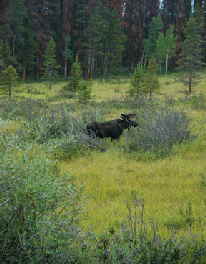 The large moose and a female nearby were foraging in the low scrub
brush while cameras were clicking, videos were rolling and the jammed traffic slowly rolled through the spontaneous road-side attraction. Such
natural attractions are not unusual in the Rocky Mountains, a couple of hours west of Denver. We saw two more feeding moose as we returned
mid-day from our visit to the Alpine Visitor Center at the pass summit of the Rocky Mountain National Park north of Grand Lake. By then we
realized the reason for the traffic jams as we slowly moved through without taking photos. The large moose and a female nearby were foraging in the low scrub
brush while cameras were clicking, videos were rolling and the jammed traffic slowly rolled through the spontaneous road-side attraction. Such
natural attractions are not unusual in the Rocky Mountains, a couple of hours west of Denver. We saw two more feeding moose as we returned
mid-day from our visit to the Alpine Visitor Center at the pass summit of the Rocky Mountain National Park north of Grand Lake. By then we
realized the reason for the traffic jams as we slowly moved through without taking photos.
Every one should visit Rocky Mountain National Park once in their lifetime. It is truly an experience that highlights the majestic natural landscape of
this part of the U.S. Proclaimed the tenth national park by President Woodrow Wilson on January 26, 1915, the park represents 415 square
miles full of natural, pre-historic and native American history. The park itself is surrounded by national forests and wilderness preserves, making
this area a hiking and camping heaven. This was home to the Ute and Arapaho Indians, who lived off the land by hunting and gathering edible
plants. Original Ute trails still exist and follow part of the continental divide. It's always a wonder to imagine their efforts at survival in this
beautiful and sometimes inhospitable environment.
 The mountain peaks, ranging as high as 14,000 feet above sea level, are home to an
abundant variety of wildlife. Visitors can join scheduled ranger-led nature walks as well camping, bicycling, rock climbing and horseback riding. In the winter,
snowmobiles and cross country skiing are popular for the hearty. Rocky Mountain National Park is open 24 hours a day year round, but the road to the visitors' area at
the summit is closed between October and May. The mountain peaks, ranging as high as 14,000 feet above sea level, are home to an
abundant variety of wildlife. Visitors can join scheduled ranger-led nature walks as well camping, bicycling, rock climbing and horseback riding. In the winter,
snowmobiles and cross country skiing are popular for the hearty. Rocky Mountain National Park is open 24 hours a day year round, but the road to the visitors' area at
the summit is closed between October and May.
Driving to and from the Alpine Visitors Center at the summit was an experience in itself. Although the road is in very good condition, it is narrow, so the switchbacks
become even more "scenic" when you can just look down to the abyss below. As you ascend to the summit at a little over 12,000 feet, you can feel the thinner air and the
cold winter wind that blows year round. The treeline easily marked where the mountains turn into glacier
territory. Bring your binoculars to spot elk and moose in the expansive vistas that may be far from any road.
The quaint little town of Grand Lake is at the west entrance of the Rocky Mountain National Park and
shares much of the beautiful surroundings of the park. In fact, the park surrounds it on three sides. The
Kawuneeche Visitor Center at the entrance of the park is less than a mile from the gateway town on the beautiful lake.
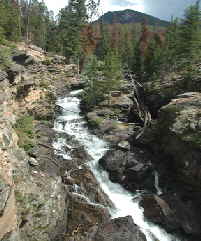
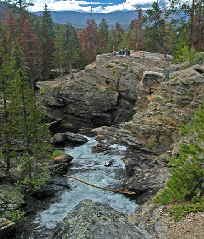 Numerous excellent maps and guides are available nearly everywhere to help visitors select where to go and what to
see. We decided to see the "roads less traveled" whenever possible and encountered Adams Falls, just outside of Grand Lake. A short 10 minute walk through the trees led us to a beautiful
waterfall and viewing area that was much less crowded than most other places we visited. Numerous excellent maps and guides are available nearly everywhere to help visitors select where to go and what to
see. We decided to see the "roads less traveled" whenever possible and encountered Adams Falls, just outside of Grand Lake. A short 10 minute walk through the trees led us to a beautiful
waterfall and viewing area that was much less crowded than most other places we visited.
For a peek at an original fishing and hunting camp, we visited the Holzwarth Historic Site near the Never Summer Ranch. As the story goes, the enactment
of prohibition in Colorado in 1916 forced John Holzwarth Sr., then a Denver saloonkeeper, to start over as a
subsistence rancher. With the completion of the Fall River Road over the Continental Divide in 1920, John
joined other valley residents in serving the increasing numbers of mountain visitors. Thus the Holzwarth's
Trout Lodge was born. The Trout Lodge lasted for 10 years before the ranch was converted to a dude
ranch that lasted for 4 decades. In 1973, John Holzwarth Jr sold it and all modern buildings were removed.
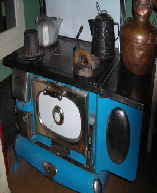 Restored to its 1920 status, you can now see what guest once paid two dollars a
day or eleven dollars a week for room and board on the American Plan (2 meals a day). Sophie (mama) Holzwarth prepared scrumptious home-cooked meals,
serving local trout, deer and grouse, and supplementing these with ranch-produced chickens, eggs and milk. All this was prepared in the kitchen of the first
homestead cabin, the "Mama" Cabin. It was western dude ranching, as it originally existed: plain and primitive, but delightful. Restored to its 1920 status, you can now see what guest once paid two dollars a
day or eleven dollars a week for room and board on the American Plan (2 meals a day). Sophie (mama) Holzwarth prepared scrumptious home-cooked meals,
serving local trout, deer and grouse, and supplementing these with ranch-produced chickens, eggs and milk. All this was prepared in the kitchen of the first
homestead cabin, the "Mama" Cabin. It was western dude ranching, as it originally existed: plain and primitive, but delightful.
Not too many people know that Colorado was once at the bottom of a vast ocean. Another interesting site was Kremmling's Fossil Ridge, west of the park, which
displays the remains of the aquatic creatures that inhabited this ancient ocean about 70 million years ago. The fossils found here are the largest specimens of
this Cretaceous group know in North America.
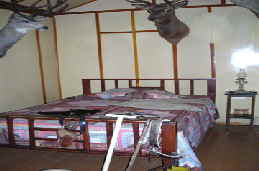 Go west, young man. Go west. Don't know who said that, but
there's something to be said for that phrase. And whoever said it must have had Grand County in mind. Returning here is a must! Go west, young man. Go west. Don't know who said that, but
there's something to be said for that phrase. And whoever said it must have had Grand County in mind. Returning here is a must!
Grand County has an excellent website with detailed information for year round visitors. Visit www.grand-county.com for your
choices!
For other articles on golfing Grand County, click here. For details on fishing, click here.
|